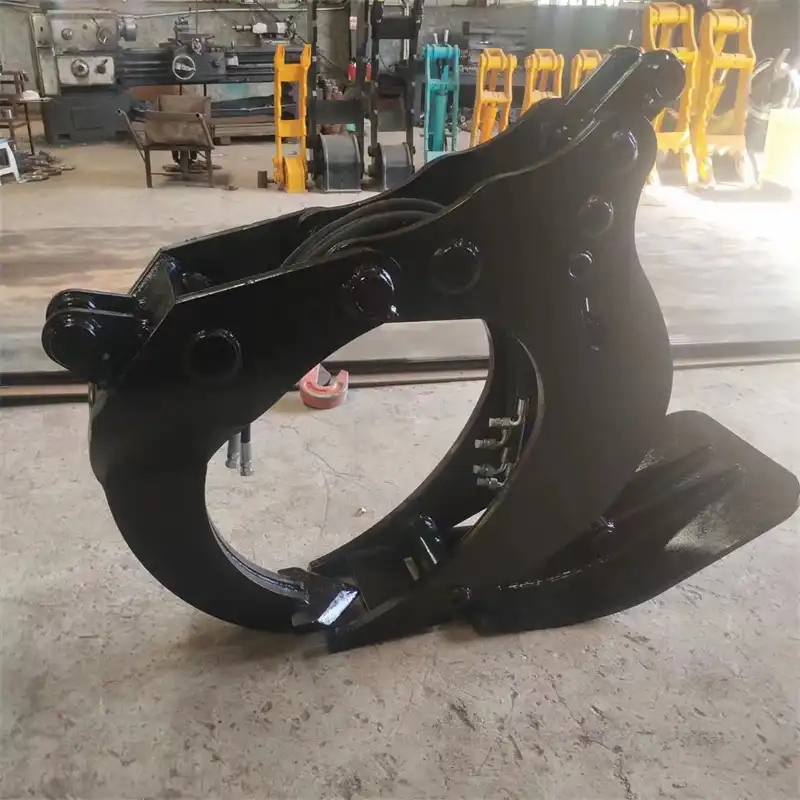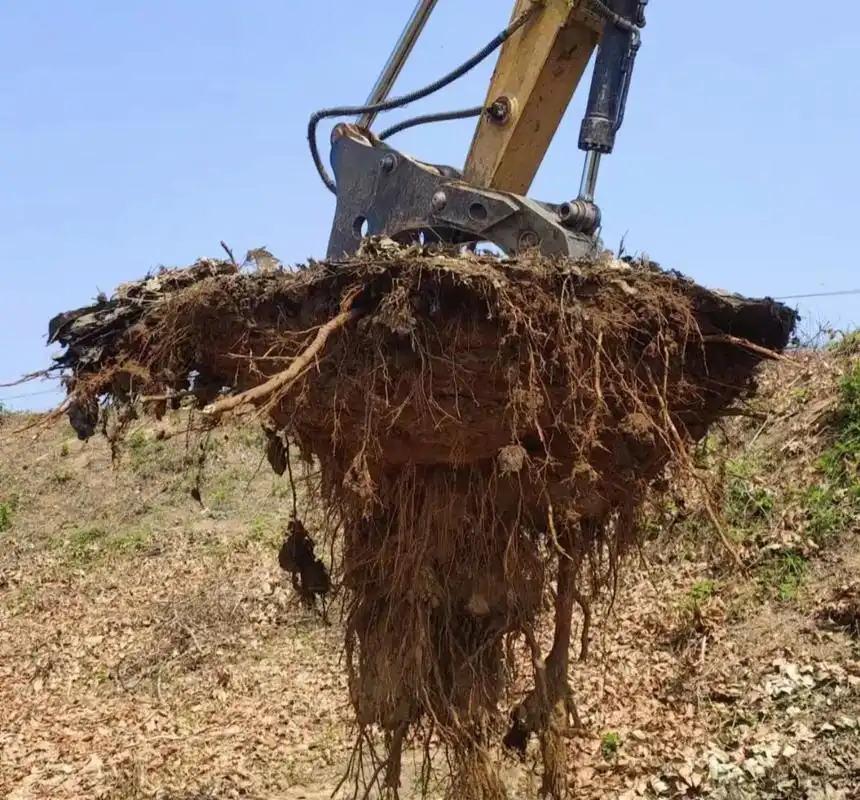What machine is best for removing stumps?
When it comes to removing tree stumps efficiently and effectively, the excavator tree stumper stands out as the premier solution for professional land clearing operations. This powerful attachment transforms standard excavators into specialized stump removal machines, offering unmatched performance for railway construction, forestry management, land development, and construction projects. Unlike traditional stump grinders or manual removal methods, the tree stumper combines raw power with precision control, making quick work of even the most stubborn root systems. The hydraulic systems of modern excavators provide the necessary force to extract stumps completely, while the articulated design of the tree stumper attachment allows operators to approach stumps from optimal angles. For companies managing large-scale clearing operations or infrastructure development, investing in a quality tree stumper delivers considerable time and cost savings over rental equipment or less efficient alternatives. The versatility of these attachments also means they can be quickly swapped out when the job requires different tools, maximizing the utility of your existing excavator fleet.
Efficiency and Power

Extraction Capabilities
The core advantage of an excavator tree stumper attachments lies in its remarkable extraction capabilities. Unlike standalone stump grinders that chip away at stumps gradually, these purpose-built attachments harness the excavator's substantial hydraulic power to completely uproot stumps in a fraction of the time. The mechanical advantage provided by the excavator's boom and arm multiplies the force applied to the stump, easily overcoming the resistance of even decades-old root systems. This extraction method ensures complete removal rather than just surface grinding, eliminating regrowth concerns and preparing sites thoroughly for construction or replanting.
Modern tree stumpers feature hardened steel teeth or specialized cutting edges designed to slice through wood fibers and root structures efficiently. These components are engineered to withstand the extreme forces involved in stump extraction while maintaining their cutting edge through hundreds of operations. The hydraulic systems powering these attachments deliver consistent performance even when encountering particularly dense or large-diameter stumps that would stall smaller equipment.
Productivity Metrics That Matter
When evaluating stump removal equipment, productivity becomes the decisive factor for project timelines and profitability. Field tests consistently demonstrate that a properly deployed excavator tree stumper can process between 30-50 stumps per day (depending on size and conditions), compared to 10-15 for dedicated stump grinders or even fewer using manual methods. This productivity advantage translates directly to labor cost savings and accelerated project completion.
The efficiency gains become even more pronounced when considering larger-diameter stumps. While conventional stump grinders may require 45-60 minutes per large stump, an excavator with a specialized tree stumper attachment typically completes the same task in 15-20 minutes. This performance difference becomes especially critical in commercial clearing operations where hundreds of stumps may need removal across expansive areas. Additionally, the excavator's mobility allows operators to move quickly between removal sites without the need for additional transport arrangements.
Return on Investment Considerations
From a business perspective, the acquisition of an excavator tree stumper represents a strategic investment with quantifiable returns. Companies that regularly undertake land clearing, infrastructure development, or forestry management projects can achieve full return on investment within 12-18 months of regular use. This calculation factors in the increased job capacity, reduced labor hours, and elimination of rental costs that would otherwise accumulate with temporary equipment solutions.
The dual-purpose nature of the system further enhances its value proposition. While dedicated stump grinders serve only one function, the excavator maintains its utility for numerous other tasks when fitted with alternative attachments. This versatility essentially transforms a single machine into a comprehensive site preparation system, reducing both the equipment inventory requirements and the logistical complications of deploying specialized machines to remote work sites.
Adaptability to Complex Terrains

Performance Across Diverse Landscapes
The remarkable versatility of the excavator tree stumper becomes most apparent when confronting challenging terrain conditions. Unlike wheeled equipment that struggles with stability on uneven surfaces, excavators provide a stable working platform through their tracked undercarriage and adjustable outriggers. This fundamental stability advantage allows tree stumper attachments to operate effectively regardless of whether the stump is situated on flat ground, sloped terrain, or even partially submerged areas.
In mountainous regions or hillside developments, the excavator's inherent stability and reach capabilities enable operators to safely remove stumps from slopes where traditional equipment simply cannot function. This terrain adaptability proves invaluable for railway construction projects that frequently traverse varied topography or forestry operations in rugged landscapes. The machine's ability to anchor itself securely while applying substantial force to embedded stumps eliminates the hazards associated with operating dedicated stump grinders on inclined surfaces.
Navigating Challenging Access Scenarios
Limited access situations present significant challenges for conventional stump removal methods. The excavator tree stumper configuration offers a practical solution through its extended reach capabilities. Modern excavator arms provide working radii of 20-30 feet, allowing operators to address stumps without requiring direct equipment access to the immediate vicinity. This reach advantage proves particularly valuable when removing stumps near structures, along fence lines, or in areas where surrounding vegetation must be preserved.
The compact footprint of smaller excavator models equipped with tree stumper attachments allows them to navigate through tight spaces while maintaining the power necessary for effective stump removal. This combination of mobility and capability enables contractors to tackle stump removal in previously inaccessible locations, such as residential backyards with narrow entry points or densely developed commercial properties where maneuverability is restricted.
Soil and Environmental Condition Versatility
Different soil compositions present varying challenges for stump removal equipment. The superior power-to-weight ratio of excavator tree stumpers enables them to perform consistently across diverse soil conditions from loose sandy soils to dense clay or even partially rocky terrain. The operator's ability to adjust the machine's approach angle and applied pressure allows for technique modifications based on the specific resistance encountered.
When working in environmentally sensitive areas or locations with underground utilities, the precise control afforded by modern excavator hydraulics enables operators to remove stumps with minimal soil disturbance beyond the immediate target area. This precision reduces the remediation work required after stump removal and preserves surrounding soil structure. For projects with strict environmental compliance requirements, this controlled approach offers significant advantages over methods that create wider disturbance patterns.
Environmental and Safety Advantages
Reduced Environmental Impact
The environmental footprint of stump removal operations deserves careful consideration in today's sustainably-focused construction landscape. The excavator tree stumper approach offers several ecological advantages compared to alternative methods. Complete stump extraction eliminates the decomposition period associated with chemical treatments, which can leach substances into surrounding soil and groundwater systems. Similarly, the clean removal process avoids the wood chip residue generated by grinding methods, which can alter soil composition and nutrient profiles when left in large quantities.
Modern tree stumpers operate with remarkable fuel efficiency relative to their output capacity. When compared to dedicated stump grinders performing equivalent work, the excavator configuration typically consumes 20-30% less fuel per stump removed. This efficiency stems from the optimized hydraulic systems of contemporary excavators and the direct application of force rather than the continuous high-speed operation of grinding equipment. For projects requiring removal of numerous stumps, these fuel savings contribute measurably to reduced carbon emissions and operating costs.
Operator Safety Enhancements
Safety considerations remain paramount in heavy equipment operations, particularly when dealing with the unpredictable forces involved in stump removal. The excavator tree stumper methodology substantially improves operator safety by maintaining considerable distance between personnel and the active work area. Unlike conventional grinders that position operators in close proximity to flying debris and rotating components, excavator cabs provide protected environments with excellent visibility of the work zone.
The reduced physical strain on operators represents another significant safety advantage. Excavator controls are designed for extended operation with minimal fatigue, utilizing joystick inputs and ergonomic seating to reduce the physical demands placed on personnel. This ergonomic advantage becomes particularly valuable during extended clearing operations where operator fatigue can otherwise compromise both productivity and safety standards. The enclosed cab also provides protection from environmental factors such as dust, noise, and weather conditions that can contribute to operator stress and reduced awareness.
Comprehensive Site Preparation
Beyond the immediate task of stump removal, the excavator tree stumper approach delivers superior site preparation outcomes that benefit subsequent construction phases. The extraction method removes not only the visible stump but also the majority of the root system, eliminating future concerns about subsidence or structural instability in developed areas. This thorough removal proves especially valuable for infrastructure projects like railways, roadways, or building foundations where subterranean stability is essential.
The excavator's versatility further enhances site preparation efficiency. After stump removal, the same machine can immediately transition to related tasks such as grading, trench digging, or material handling without requiring additional equipment mobilization. This workflow integration significantly reduces project timelines and coordination requirements. For time-sensitive developments or projects with tight sequencing requirements, this multi-functionality delivers tangible schedule advantages while maintaining consistent quality across site preparation activities.
FAQ
①How does an excavator tree stumper compare to traditional stump grinders?
An excavator tree stumper offers superior power and complete stump extraction compared to traditional grinders that primarily shred the stump to below ground level. While grinders are suitable for smaller residential projects, excavator attachments provide faster operation, deeper root removal, and better performance on large stumps typical in commercial and industrial applications.
②What size excavator is needed for effective stump removal?
Mid-sized excavators (12-20 tons) equipped with appropriate tree stumper attachments provide the optimal balance of power and maneuverability for most stump removal applications. Smaller excavators (6-10 tons) can handle residential stumps effectively, while larger stumps over 36 inches in diameter may require machines in the 20-30 ton range for efficient extraction.
③How deep can an excavator tree stumper remove roots?
A properly configured excavator tree stumper can typically extract roots to depths of 3-4 feet, significantly deeper than the 12-18 inches achieved by conventional stump grinders. This deeper extraction is particularly valuable for preventing regrowth and ensuring complete site preparation for construction projects.
About Tiannuo
When evaluating the best machine for removing stumps, the tree stumper clearly emerges as the superior solution for professional applications. Its unmatched combination of power, versatility, and efficiency makes it the preferred choice for contractors and land developers facing substantial clearing requirements. The adaptability to various terrain conditions ensures consistent performance regardless of the project location, while the environmental and safety advantages align with modern construction best practices.
For companies seeking to optimize their land clearing operations, investing in quality excavator attachments from reputable manufacturers delivers measurable returns through accelerated project timelines and reduced labor requirements. Tiannuo Machinery's excavator tree stumper exemplifies the engineering excellence required for demanding applications, with specifications designed to handle the rigors of commercial stump removal. With features like a 6700 mm maximum digging height, 5000 mm unloading height, and 0.27 m³ bucket capacity, this attachment transforms standard excavators into specialized stump removal solutions.
For more information about Tiannuo's products and other excavator attachments tailored for your specific application requirements, contact our technical team at tn@stnd-machinery.com.
References
Johnson, R. (2023). Modern Excavator Attachments: Transforming Construction Efficiency. Heavy Equipment Review.
Zhang, L. & Williams, P. (2024). Comparative Analysis of Stump Removal Methods in Commercial Land Development. Journal of Construction Technology.
Patel, S. (2023). Environmental Impact Assessment of Mechanical Stump Removal Techniques. Forestry Management Quarterly.
Thompson, K. (2024). Safety Protocols for Heavy Equipment Operation in Land Clearing Projects. Industrial Safety Standards Journal.
Garcia, M. & Kim, H. (2023). Cost-Benefit Analysis of Specialized Equipment in Infrastructure Development. Construction Economics Review.
About Author: Arm
Arm is a leading expert in the field of specialized construction and railway maintenance equipment, working at Tiannuo Company.

